
This manuscript is for personal enjoyment and information.
THIS MUST BE THE MOST MAGICAL WORD IN THE ENGLISH LANGUAGE:
WHERE TO FIND GOLD:
IN ALBERTA
The fine Alberta gold is found on the upstream end of the gravel bar, on an
inside turn. The gold is just below the surface, about three to six inches. The
Peace River: 
Near the town of Peace River has had some favorable results. First you go 200 to 300 feet above the water-line of the riverbed. The gold can then be located in the upper two feet of that gravel bar.
The North Saskatchewan River:
( near Edmonton, South of Stony Plain, and about 15 miles down stream from Fort Saskatchewan).
The Red Deer River: Upstream near Red Deer. In the upper faces of the gravel bars, between the high and low water.
(Along the river from below Hargwen to a point near Marlboro, from Reservoir to 6 miles below Peers Ferry. Up river from Whitecourt about five miles). The Athabasca River:
Starting from Fort Assiniboine, and around the vicinity of the town of
Athabasca. Also by the bridge crossing the Little Smoky River, north of
Valleyview, on the road to High Prairie. By the bridge west of Dunvegan, one
student found a FLAKE of gold, "Not Just Color". Has been reported that gold was
recovered from the Athabasca River, near Blueridege by the ferry. Arizona - Riddled with tales of gold mines, Arizona has a rich and colorful
history of lode and placer dispories. Cochise County has recorded B - two and a
half million ounces of gold from lode production, but is desively poor in placer
deposits. Reasonable amounts of gold come out of Mohave, Pima, Yavapai and Ypa
Counties. The Bisbee, Tombstone, Turquoise, Gila, Ask Peak, Clifton-Morenci,
Vulture, Wallapai, Ajo, Mammoth, Pinal County,Superior, Big Bus, Maricopa,
Pingrove-Tiger districts have yielded vast amounts of gold, but have either come
from hardrock lode operator as a by-product from copper, sulfide ore,or siIver
production. The more interesting areas for the modem prospector would be the
following: Bisbee , Ash Canyon in the Huachuaca Mountains, Payson Placers, in
Gila county; the Globe-Miami District, the San (Dingo) Placers and Vulture
District in Maricopa county; Pina County's Alder Canyon; Armargosa, Papago and
Quijotoa Placers; the areas in Yavapal County include Granite ,Groom Creek,
Placerita Placer and the Silwer-Rich Hill District; the LaPaz and Plomosa ,
LaCholla Placer, and Muggins Mountain of Yuma County. Oatmam (the San Francisco
district, including the Vivian, Gold Road, and Boundary Cone localities in an
area about 10 mi. Iong by 7 mi. wide on W slopes of S part of the Black Mts.,
with Union Pass sometimes included, discovered in 1864, with tot. prod. through
1931 of 2,045,400 ozs. of lode gold) (1) area (a)the Tom Reed Property
(extremely rich), including the Pasadena,Aztec Center, and Big Jim-Aztec
mines--lode gold;(b) beneath town, the Tip Top ore body;(c) 1 1/2 mi. NE of the
Tom Reed,the Gold Road Mine, discovered in 1900,very rich--lode gold;(2) very
many other rich lode mines, e.g., the Gold Dust,Ben Harrison, Leland One standing at: a high vantage point after unusually heavy spring runoff. If
you drop a relatively large lump of gold, say an almond, in this fast moving
water, Were does it travel? If the stream were fast and with little obstruction,
our test lump of gold probably travel uninterrupted for the most of the stream.
But nature doesn't form that are smooth, straight, and narrow. There are new
tributary, outcropping, variation in, will determine the velocity at each site.
(Boulder or bedrock outcropping at inside bend will cause the formation of a
gravel bar- prospect its upstream end.) If we were to drop our large nuggrt in a
fast moving water with only one obstruction,such as a large boulder. The boulder
would have an area of still or relatively calmer water on its down side. ln all
likelihood our lump of gold wouId be travelling at a more-or-less constant rate
pushed a]ong by the force of the water. However,on reaching and being swept
around the boulder, the nugget's weight would most likely cause it to stop and
hold its position in the calmer water on the lee side of the boulder, there to
rest under water gradually receded. Let us take another instance using a
straight narrow hypothetical stream of a fixed grade (river 2)swelled by a
spring runoff. Midway trough its course imagine a sharp bend. Several hundered
feet above this bend we drop in our test nugget. From our vantage point we see
the nugget being swept along down the straight, smooth part stream until it
reaches the point where the stream begins to make its sharp curve. You must be able to separate the gold from the black sand, and other
concentrate which has accumulated in your pan. These three factors are closely
interrelated. Being an expert on locating placer deposits is useless if you are
unable to pan it. Being an excellent gold panner won't get you much gold if you
can't separate it from the black sand and the other concentrate.
When prospecting for gold: Look at it as a recreation, not how much can I
make mining for gold. Before you sell everything you have to mine for gold take
a good look at the possibility of ont making any money.
GOLD PANS:
Steel Pan: - There is oil on the surface of a new pan. First You must burn
off the oil, on an open fire pit. Heat the pan until it's an even blue all over,
then dunk in cold water. Then lay the pan face down, to dry. This will leave the
pan with a blue color, so the flour gold can be easily seen. You must burn the
pan every time there are rust spots, or not blue any more. PROSPECTING:
PANNING: -
Place the pan under the water, and vigorously shake it side to side, about 5
seconds. Swirl the gravel in the pan, in a gentle circular motion to the right,
about 2 seconds, and then to the left for 2 seconds. This causes the material in
the pan to break up, and the heavy material (gold) to drop. If there is clay, or
grass roots, set the pan in 6 inches of water, and physically work you fingers
through it. This action will cause every bit of material to become exposed to
the water. When you work the material by hand throw out the larger rocks. If
there is clay on the rocks, be sure to remove all of it, as this is where much
of the gold will come from. REMEMBER, Gold is eight times heavier than ordinary sand and gravel. It may
be necessary to perform the "shake and rake" operation two or three times to get
all the small rocks out of the pan. This will make the next step of panning much
easier; to wash the remaining light worthless material out of your pan, and get
to the gold underneath. Hold the pan just barely in the water with the proper
tilt. Then with a slight thrust forward, some of the brown sand will wash out of
the pan. When you have washed away some of the light gravel stop and shake your
pan side to side, under the water, with out any tilt to the pan. This will cause
any 'wandering' gold to settle back down to the bottom of the pan. Then repeat
the circular motion, bringing the pan almost out of the water, with the correct
tilt. In light of the devaluation of the peso in Mexico, gold is an excellent
investment. If you put $800 US in gold in 1980 you would have 28 grams. You
would now have the same amount of gold worth only half it's original value,
where as if you invested in Mexico, you would have lost all your value.
The governments of the world lie about the value of their currencies. So why
not invest in gold? Gold has several qualities that few other metals have. One
is that it has purity. Gold is rarely found contaminated with other mineral.
Gold also has density. That is, it is heavy for such a brilliant metal. A inch
cube of gold would weight almost a troy pound. Gold is very ductile. It can be
drawn out into a very thin wire before breaking. Gold also has a mythical
quality about it. It was and still is believed to have magicaial powers. From
ancient times until the present people have believed that if you have gold you
would have a longer and richer life. If you build a sluice box and work at it,
you can have your own gold pyramid, if only in minature. (casting jewlery
another hobby)
Click on Bert's photo to view Peruvian goldminer.A booming, makeshift gold mine spills down the mountainside at Serra Pelada, in the Amazon forest of Brazil. Nuggets as hefty as 15 pounds have been unearthed here by the luckiest of some 20,000 prospectors and laborers, who work by hand their tiny claims of only four square meters. All gold is sold to the government, which is counting on the regions mineral wealth - iron ore, bauxite, and manganese, as well as gold - to offset a ponderous foreign debt .
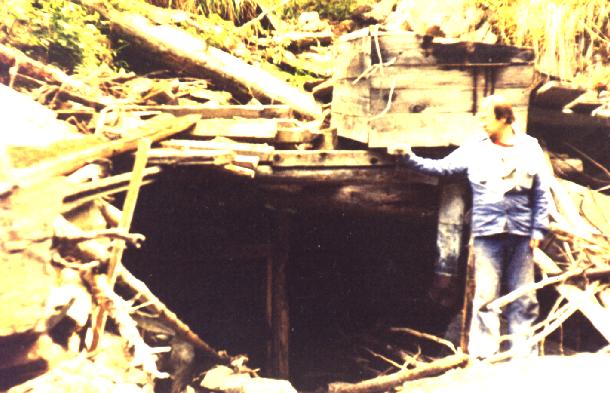
Me and my nonpofitable gold drift mine.
IN WESTERN U.S.A.
 Midnight,Sunnyside,Iowa,Lazy
Boy, etc.; (3)the Moss Vein (4) N 1 mi., at Goldroad(Katherine), rich
mines--lode gold;(5) SW 1 1/2 mi., the Pioneer (German-American) Mine--lode
gold; (6) NW 5 mi. (6 mi. downstream from US 66 in valley of Silver
Cr.),placers, (7) NW 7 mi. and 2 mi. N of Silver Cr.,the Moss Mine--lode gold
(8)NNW 12 mi. extending from Union Pass NW in the Black Mts (summit of Rte. 68
to Bullhead City), W to the Colorado R., in sec. 5(21N-20W), the Katherine Mine,
discov- ered in 1900, rich producer--85 per cent lode gold, 15 per cent
silver;(b) 4 mi. E of the Gold Standard mill, the Roadside Mine-- lode
gold,silver;(c) 3 1/2 mi. SW of the Roadside, in sec. 20, the Arabian Mine--lode
gold,with twice as much silver;(d)other rich area lode mines are:the
Tyro,Sheeptail- Boulevard,Frisco,Black Dyke Group,Pyramid, and Golden
Cycle--gold,silver.
Midnight,Sunnyside,Iowa,Lazy
Boy, etc.; (3)the Moss Vein (4) N 1 mi., at Goldroad(Katherine), rich
mines--lode gold;(5) SW 1 1/2 mi., the Pioneer (German-American) Mine--lode
gold; (6) NW 5 mi. (6 mi. downstream from US 66 in valley of Silver
Cr.),placers, (7) NW 7 mi. and 2 mi. N of Silver Cr.,the Moss Mine--lode gold
(8)NNW 12 mi. extending from Union Pass NW in the Black Mts (summit of Rte. 68
to Bullhead City), W to the Colorado R., in sec. 5(21N-20W), the Katherine Mine,
discov- ered in 1900, rich producer--85 per cent lode gold, 15 per cent
silver;(b) 4 mi. E of the Gold Standard mill, the Roadside Mine-- lode
gold,silver;(c) 3 1/2 mi. SW of the Roadside, in sec. 20, the Arabian Mine--lode
gold,with twice as much silver;(d)other rich area lode mines are:the
Tyro,Sheeptail- Boulevard,Frisco,Black Dyke Group,Pyramid, and Golden
Cycle--gold,silver. 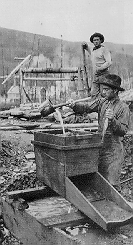 Topock: (1) SE 18 mi.:
(a)in SW part of co., in foothills of the Chemehuevis placers; (b) at SW foot of
the mts., in area of the Red Hills
Topock: (1) SE 18 mi.:
(a)in SW part of co., in foothills of the Chemehuevis placers; (b) at SW foot of
the mts., in area of the Red Hills 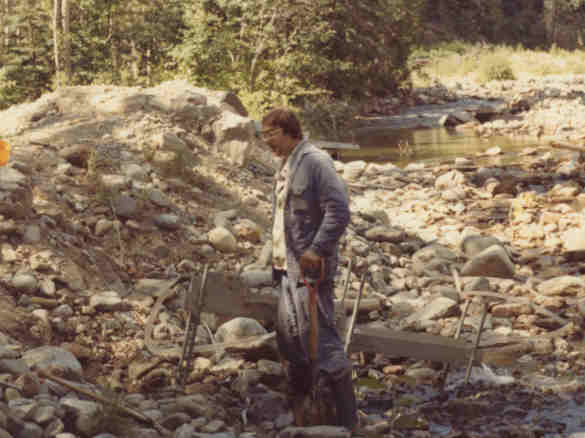 , the Mexican or Spanish
diggings (most productive)--placer gold;(c)NE side of mts.,area placer and
lode-gold mines;(3) SE 55 mi.;(a) the Best Bet (Kempf)Mine--lode gold;(b) a few
mi. N of the Best Bet,the Gold Wing Mine(and district), with other area
prospects--lode gold;(c) on opposite side of mts., the Dutch Flat Mine--lode
gold.
, the Mexican or Spanish
diggings (most productive)--placer gold;(c)NE side of mts.,area placer and
lode-gold mines;(3) SE 55 mi.;(a) the Best Bet (Kempf)Mine--lode gold;(b) a few
mi. N of the Best Bet,the Gold Wing Mine(and district), with other area
prospects--lode gold;(c) on opposite side of mts., the Dutch Flat Mine--lode
gold.  Pima Co. Pima County ranks
seventh among Arizona's gold-producing counties, with a total production of
$3,212,000 through 1931, of which two thirds came as a by-product of copper
refining. Ajo (major copper center with enormous open-pit mine, which produced
990,000 ozs. of by-product gold, 1924-59) (1) the New Cornelia Mine, open-pit,
specboular; (2) S 30 mi. via branch from old Sonoita rd. and about 6 mi. W of
Dripping Springs in the Puerto Blanco Mts.,the Golden Bell Mine--lode gold.
Arivaca (1) in area of the Las Guijas Mts.: (a) the Las Guijas (Arivaca)
placers, very productive; (b) along Arivaca Cr., in large channel along SW slope
of mts., and (c) along Las Guijas Cr., along the NE slope (much smaller, drier),
placers worked intermittently to the present;(2)regional pediment slopes, mesas,
and watercourse beds,placers(mostly dry-wash);(3) pediment at N foot of
mts,;(a)from pediment itself,and (b)from area arroyos and gulches, large-scale
places(operated in 1933)
Pima Co. Pima County ranks
seventh among Arizona's gold-producing counties, with a total production of
$3,212,000 through 1931, of which two thirds came as a by-product of copper
refining. Ajo (major copper center with enormous open-pit mine, which produced
990,000 ozs. of by-product gold, 1924-59) (1) the New Cornelia Mine, open-pit,
specboular; (2) S 30 mi. via branch from old Sonoita rd. and about 6 mi. W of
Dripping Springs in the Puerto Blanco Mts.,the Golden Bell Mine--lode gold.
Arivaca (1) in area of the Las Guijas Mts.: (a) the Las Guijas (Arivaca)
placers, very productive; (b) along Arivaca Cr., in large channel along SW slope
of mts., and (c) along Las Guijas Cr., along the NE slope (much smaller, drier),
placers worked intermittently to the present;(2)regional pediment slopes, mesas,
and watercourse beds,placers(mostly dry-wash);(3) pediment at N foot of
mts,;(a)from pediment itself,and (b)from area arroyos and gulches, large-scale
places(operated in 1933)  Calffornia_ This is really the
motherlode of all gold producing of the United States. More importantly, it
amateur's (as well as a professional's) drcam. The richness of the California
motherlode has been attributed to the gradual erosion and subsequent
accumulation of gold from ancient rivers, of major proportions, that ran in a
south-southeasterly direction through the central part of the state. The forces
that formed the earth, moved and broke-up forces displaced the ancient rivers.
The rivers cut a right angles through the Sierra Nevada and fabled Big Blue
Lead(that carry its rich treasure) These other ancient river channels are
theorized to have been off-shoots, tributaries if the word is appropriate for so
large a river system, from a "super" river. The theory being that before the
break-up of the continents, the ancient, monster water channel ran all the way
from what is now the South American coastline, up through Mexico and through the
western corridor to Canada;each tilting and breaking of its old path further
segmenting its branches and obscuring more of its original course. Where these
channels were forced closest to the surface and not protected by ancient lava
flows, the canyons and fissures that cut into it released its mineral wealth. It
is therefore the drainages of the western slope of the Sierras that have always
attracted the most interest.
Calffornia_ This is really the
motherlode of all gold producing of the United States. More importantly, it
amateur's (as well as a professional's) drcam. The richness of the California
motherlode has been attributed to the gradual erosion and subsequent
accumulation of gold from ancient rivers, of major proportions, that ran in a
south-southeasterly direction through the central part of the state. The forces
that formed the earth, moved and broke-up forces displaced the ancient rivers.
The rivers cut a right angles through the Sierra Nevada and fabled Big Blue
Lead(that carry its rich treasure) These other ancient river channels are
theorized to have been off-shoots, tributaries if the word is appropriate for so
large a river system, from a "super" river. The theory being that before the
break-up of the continents, the ancient, monster water channel ran all the way
from what is now the South American coastline, up through Mexico and through the
western corridor to Canada;each tilting and breaking of its old path further
segmenting its branches and obscuring more of its original course. Where these
channels were forced closest to the surface and not protected by ancient lava
flows, the canyons and fissures that cut into it released its mineral wealth. It
is therefore the drainages of the western slope of the Sierras that have always
attracted the most interest.  ONE - TWO - THREE Before putting
that gold pan into the car and starting for that secluded spot by the river, you
must be aware of three equal important factors. ONE: You must know where to look
for gold on a gravel bar, by a stream or river.
ONE - TWO - THREE Before putting
that gold pan into the car and starting for that secluded spot by the river, you
must be aware of three equal important factors. ONE: You must know where to look
for gold on a gravel bar, by a stream or river.  TWO: The way to approach the
study of the top map is to look for areas where the stream will be making a
sharp turn. Gold, original point of deposit into the stream, rally move during
periods of heavy flood/water, during this period of heavy water flow several
factors effect the speed of the water: namely the stream(the amount of drop or
angle of the stream, particular distance), and the width to cross were the gold
has been freshly deposited,short distance will cause it to quickly settle and
embed in various cracks, fissures, roots, and obstacles in its path as it moves
down/ will, therefore, take substantial velocity to move again(Newton's "object
at rest").Unuaually heavy flooding, which occur yearly,tend to rearrange these
deposits.
TWO: The way to approach the
study of the top map is to look for areas where the stream will be making a
sharp turn. Gold, original point of deposit into the stream, rally move during
periods of heavy flood/water, during this period of heavy water flow several
factors effect the speed of the water: namely the stream(the amount of drop or
angle of the stream, particular distance), and the width to cross were the gold
has been freshly deposited,short distance will cause it to quickly settle and
embed in various cracks, fissures, roots, and obstacles in its path as it moves
down/ will, therefore, take substantial velocity to move again(Newton's "object
at rest").Unuaually heavy flooding, which occur yearly,tend to rearrange these
deposits.
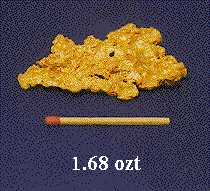 : A Nuget's Travels
: A Nuget's Travels
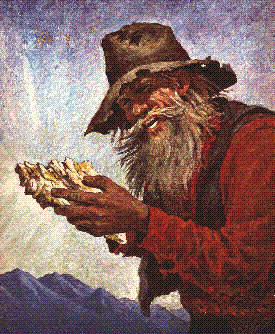 In a straight channel the current is swifter
near the mlddle than near the sides and is swifter above mid-depth than below.
On arriving at a bend the whole stream resists change of course, but the
resistance is more effective for the swifter parts of the stream than for the
slower. The upper central part is deflected least and projects itself against
the outer bank. In so doing it displaces the slow-flowing water previously near
the bank, and that water descends obllquely. The descendJng water displaces In
turn the slow-flowing lower water, which is crowded toward the inner bank, while
the water previously near that bank moves toward the middle as an upper layer.
One general result is a twisting movement, the upper parts of the current
tending toward the outer bank and the lower toward the inner.
In a straight channel the current is swifter
near the mlddle than near the sides and is swifter above mid-depth than below.
On arriving at a bend the whole stream resists change of course, but the
resistance is more effective for the swifter parts of the stream than for the
slower. The upper central part is deflected least and projects itself against
the outer bank. In so doing it displaces the slow-flowing water previously near
the bank, and that water descends obllquely. The descendJng water displaces In
turn the slow-flowing lower water, which is crowded toward the inner bank, while
the water previously near that bank moves toward the middle as an upper layer.
One general result is a twisting movement, the upper parts of the current
tending toward the outer bank and the lower toward the inner.  Another result is that the
swiftest current is no longer medial, but is near the outer or concave bank.
Connected with these two is a gradatlon of velocities across the bottom, the
greater velocltses being near the outer bank. The bed velocities near the outer
bank are not only much greater than those near the inner bank but they are
greater than any bed veloclties in a relatively straight part of the stream.
They have therefore greater capacity for traction, and by increasing the
tractional lead they erode until an equilibrium is attained. On the other hand,
the currents which, crossing the bed obliquely, approach the inner bend are
slackening currents, and they deposlt what they can no longer carry. quoted from
G. N. Gilbert, Geology of Placer Deposits, Divisiorl of Mines and Geology, SP
34, (Inside bends have heavier gravel deposits and trap gold)
Another result is that the
swiftest current is no longer medial, but is near the outer or concave bank.
Connected with these two is a gradatlon of velocities across the bottom, the
greater velocltses being near the outer bank. The bed velocities near the outer
bank are not only much greater than those near the inner bank but they are
greater than any bed veloclties in a relatively straight part of the stream.
They have therefore greater capacity for traction, and by increasing the
tractional lead they erode until an equilibrium is attained. On the other hand,
the currents which, crossing the bed obliquely, approach the inner bend are
slackening currents, and they deposlt what they can no longer carry. quoted from
G. N. Gilbert, Geology of Placer Deposits, Divisiorl of Mines and Geology, SP
34, (Inside bends have heavier gravel deposits and trap gold)
 The water on the inside of that
curve will be going slower than at any other point in the bend, therefore
enabling our nugget to resist and settle in side curve. Its weight will cause
the gold to go in a straight path following a line of least resistance from
inside bend to inside bend. Another example relating to resistance and action of
gold would be our stream with equal obstuctions throughout, but which suddenly
increases its width at the midway point , our test nugget would travel along
quite well, moved by the constant flow of water until reached the point where
the stream widened. Wider point ofFers the water a chance to slow, affording the
gold an opportunity to settle in a slower water. The transporting power of a
stream is dependent on its velocity, which is a variant determined by the
gradient, volume and load.
The water on the inside of that
curve will be going slower than at any other point in the bend, therefore
enabling our nugget to resist and settle in side curve. Its weight will cause
the gold to go in a straight path following a line of least resistance from
inside bend to inside bend. Another example relating to resistance and action of
gold would be our stream with equal obstuctions throughout, but which suddenly
increases its width at the midway point , our test nugget would travel along
quite well, moved by the constant flow of water until reached the point where
the stream widened. Wider point ofFers the water a chance to slow, affording the
gold an opportunity to settle in a slower water. The transporting power of a
stream is dependent on its velocity, which is a variant determined by the
gradient, volume and load.  gold cookies
THREE:
gold cookies
THREE:
 Black Plastic Pan: - This pan
does not need to be burned: The black plastic pan is good for cleaning up after
sluicing, it has a sand blasted surface. Also it's a good prospecting pan,
rather then the steel pan, it doesn't rust, and the gold can easily be seen.
Black Plastic Pan: - This pan
does not need to be burned: The black plastic pan is good for cleaning up after
sluicing, it has a sand blasted surface. Also it's a good prospecting pan,
rather then the steel pan, it doesn't rust, and the gold can easily be seen.
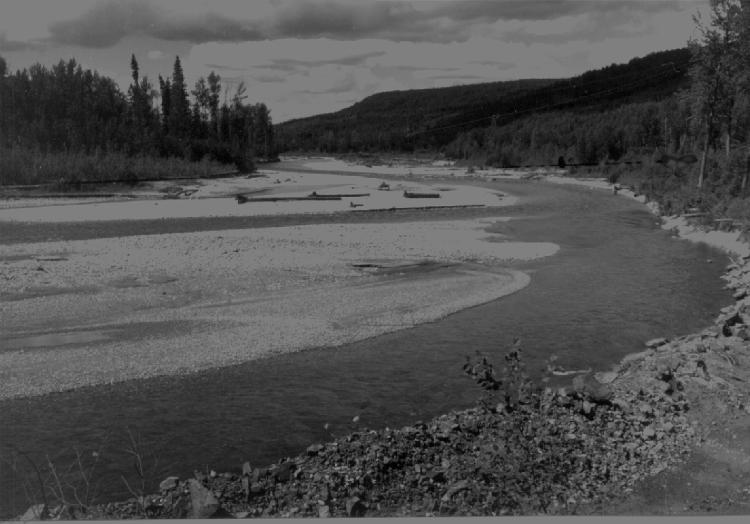 The next step is the process of
working the small rocks to the surface. Pick up your pan, submerge it under
water and, repeat the circular motion to the right, then to the left. Then
agitate it side to side, with the proper tilt, dozens of small rocks are free
and topple over the side. You also can use the side of your hand to 'rake off
the top', and don't worry about raking out any gold. By using this same
agitation that caused the lighter rocks to surface also causes the gold to sink
down into the pan.
The next step is the process of
working the small rocks to the surface. Pick up your pan, submerge it under
water and, repeat the circular motion to the right, then to the left. Then
agitate it side to side, with the proper tilt, dozens of small rocks are free
and topple over the side. You also can use the side of your hand to 'rake off
the top', and don't worry about raking out any gold. By using this same
agitation that caused the lighter rocks to surface also causes the gold to sink
down into the pan.
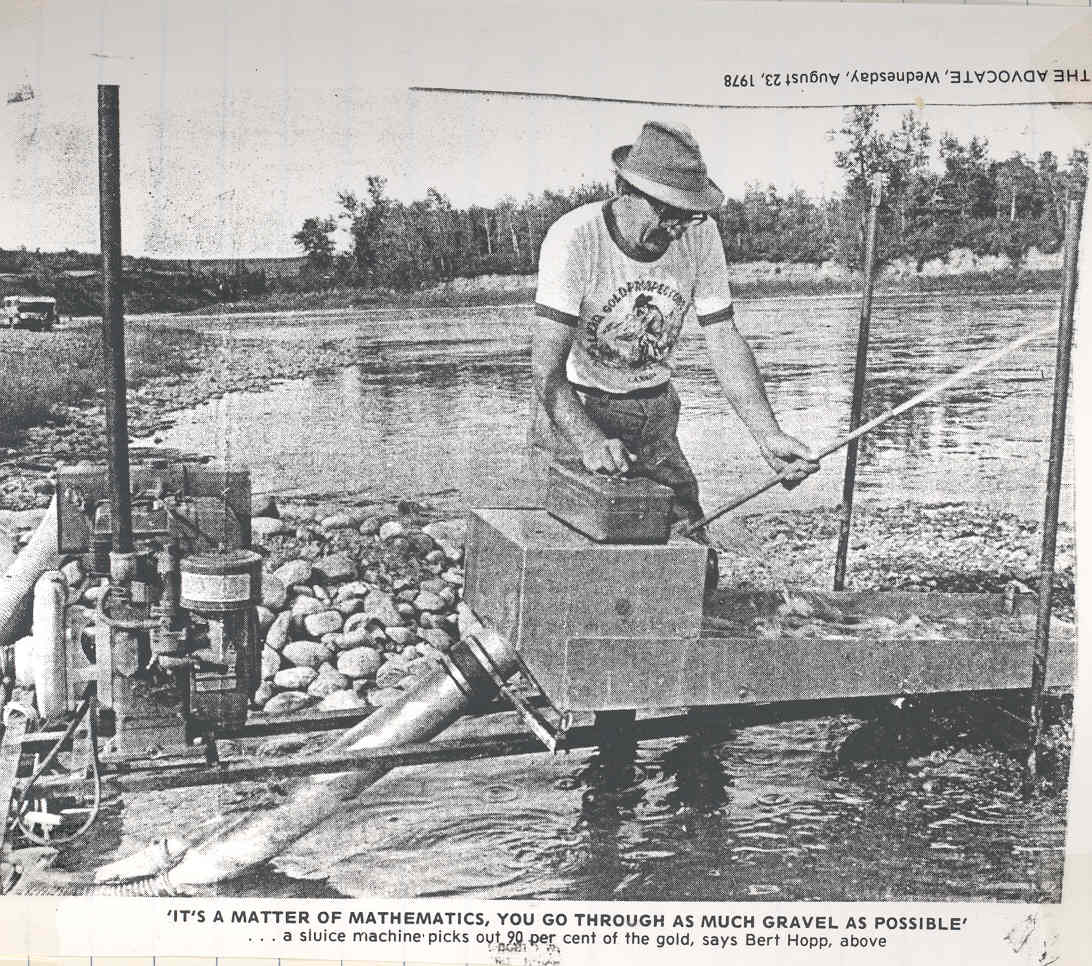 Then thrust forward again, to
wash out more waste material. Again stop to reshake your pan, without the tilt.
Repeat this washing process until, you have worked down to the heavy black sand.
This will be the last remaining substance in your pan. The panning process is
completed. This is what we call 'concentrate'. Dump this concentrate into an ice
cream bucket, which has water in it. Use your hand to splash water into the pan
to wash the concentrate out of the pan and into the ice cream bucket. After
several pans, when you have a fair amount of concentrate, you go into the
extraction process. This extraction process you can do in your back yard. Set up
a tub filled with water "to which non-sudsy soap is added. This prevents the
gold from floating. Have some additional pail of soapy water handy. Screen the
larger rocks out of the concentrate. Then add it to your black plastic pan
(which has been scuffed up on the surface by panning some gravel). Pan into the
tub using the back wash method to get the brown sand and garnets out. When you
have panned out all the garnet & sand, you can run a magnet through to pick
out the magnetic black sand. The magnet is in a pill bottle. When you run the
magnet through the black sand, have about two inches of water on top of it.
Without the water over it the black sand acts like tweezers, pinching some of
the gold with it, as it attracts to the magnet. When you swish the magnet around
in the water and black sand, the gold flakes should drop out. Release the black
sand, by pulling the magnet out of the pill bottle. There is no need to save
this black sand, although if you wish you can drop it into a gold pan and check
for gold. When all the magnetic black sand has been picked out with the magnet,
transfer the concentrate into the Garrett "gravity trap" green plastic pan. The
Kelly green is particular good, because you can see the black sand and gold. The
gravity trap pan, forces the gold to the bottom of the pan. Making it possible
to pan out all the unmagnetic black sand, thus leaving you with gold only.
Then thrust forward again, to
wash out more waste material. Again stop to reshake your pan, without the tilt.
Repeat this washing process until, you have worked down to the heavy black sand.
This will be the last remaining substance in your pan. The panning process is
completed. This is what we call 'concentrate'. Dump this concentrate into an ice
cream bucket, which has water in it. Use your hand to splash water into the pan
to wash the concentrate out of the pan and into the ice cream bucket. After
several pans, when you have a fair amount of concentrate, you go into the
extraction process. This extraction process you can do in your back yard. Set up
a tub filled with water "to which non-sudsy soap is added. This prevents the
gold from floating. Have some additional pail of soapy water handy. Screen the
larger rocks out of the concentrate. Then add it to your black plastic pan
(which has been scuffed up on the surface by panning some gravel). Pan into the
tub using the back wash method to get the brown sand and garnets out. When you
have panned out all the garnet & sand, you can run a magnet through to pick
out the magnetic black sand. The magnet is in a pill bottle. When you run the
magnet through the black sand, have about two inches of water on top of it.
Without the water over it the black sand acts like tweezers, pinching some of
the gold with it, as it attracts to the magnet. When you swish the magnet around
in the water and black sand, the gold flakes should drop out. Release the black
sand, by pulling the magnet out of the pill bottle. There is no need to save
this black sand, although if you wish you can drop it into a gold pan and check
for gold. When all the magnetic black sand has been picked out with the magnet,
transfer the concentrate into the Garrett "gravity trap" green plastic pan. The
Kelly green is particular good, because you can see the black sand and gold. The
gravity trap pan, forces the gold to the bottom of the pan. Making it possible
to pan out all the unmagnetic black sand, thus leaving you with gold only.